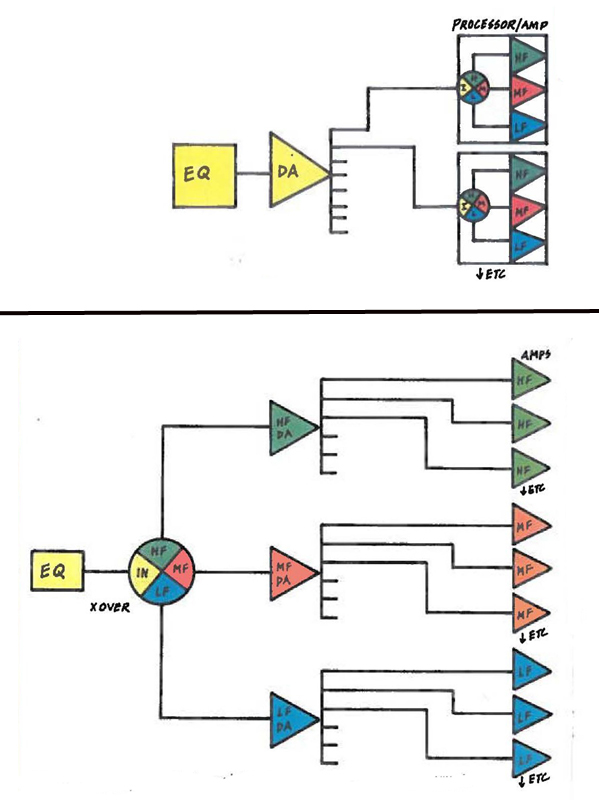
Or, looking at it another way, a single crossover output can drive more amps than you can afford. Does that mean you really want to drive all those amps from a single crossover output? Well no, not likely, and there are a number of reasons.
In either of the philosophical situations discussed earlier, it is necessary to send the same signal to a number of different places. In one case, a full range signal is being distributed to a number of identical amp racks to be divided up by the crossover/processor; in the other case, crossover outputs are being sent to additional amp blocks, as required.
In either case, paralleling a large number of inputs on a single output increases the chances of noise pickup, and decreases the reliability of the signal source. In the case of a parallel network, any noise picked up on any branch of the network is connected at the source to all other branches. Similarly, each branch of the network is a weak link for the whole network. A short circuit on one cable will pull the whole network down, as the source busily drives all the signal into the short.
Note that it doesn’t have to be a dead short to be a problem. If the short is 1,000 ohms, that is still adequately low, in comparison to all those 20,000-ohm inputs the source is driving, to send the signal where it does no good. If the impedance of the short is approaching the output impedance of the source, you will start to see current limiting and distortion, just in case you hadn’t already noticed there was a problem.
Daisy-chaining is a parallel network as well, unless the daisy-chain in/out is buffered with a stage of unity gain amplification. There is an additional headache with daisy-chained inputs: The whole chain can be jeopardized by a problem in a cable early in the chain. Try to sort that one out in a hurry! No fun at all.
The magic remedy that will lead to cleaner, quieter, more reliable systems is the distribution amp. By using a distribution amp (DA), you can reduce problems in distributing signals. It is easy to see how you can improve reliability. A DA has a number of individually buffered balanced amp outputs that are isolated from each other, preventing a short circuit or an induced noise (as opposed to a grounding problem related noise, which can still show up everywhere) from affecting the other sends.
A problem developed in one signal line will not affect the whole system. This reduces the opportunity for problems and speeds troubleshooting as well. See the two diagrams of possible distribution schemes in Figure 1.
Gain Staging
Another opportunity to improve signal quality presents itself when using a DA. Because many DAs have high level capabilities, it is possible to elevate the levels used to distribute signals.
Signal-to-noise ratio is often limited by the noise floor present in the signal distribution of the system, as opposed to the amplification or gain stages. The signal may have been fairly quiet when it left the console, but cables passing to and from amps might drape over an AC cable, sit too close to power transformers, run by a lighting cable, whatever… your noise floor is often limited at the site.

